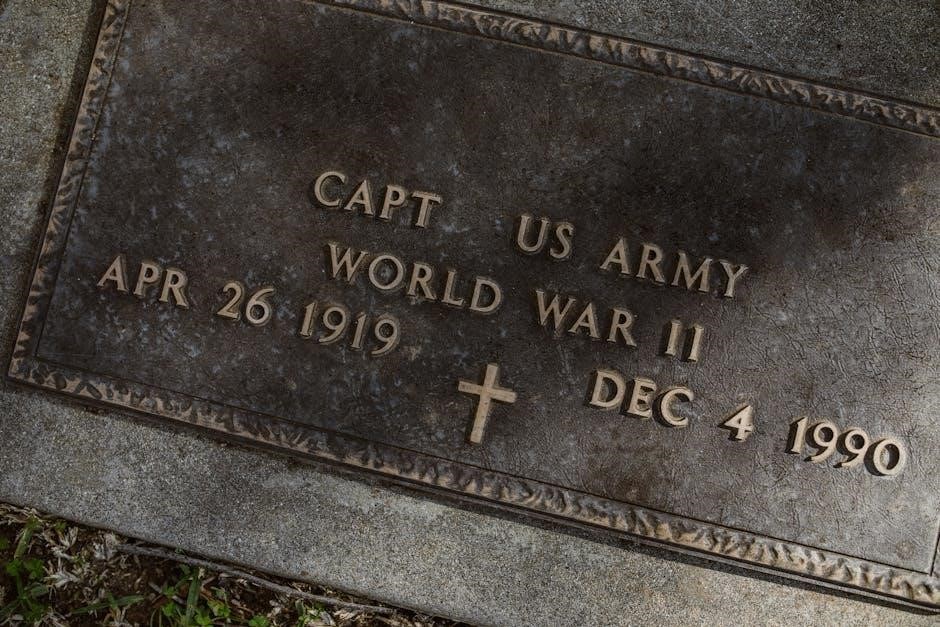o captain my captain pdf

“O Captain! My Captain!” is a powerful elegy by Walt Whitman, written in mourning of President Abraham Lincoln’s assassination. It captures the nation’s grief and reflects on leadership, loss, and enduring legacy, resonating deeply in American literature and culture.
1.1 Historical Context of the Poem
“O Captain! My Captain!” was written by Walt Whitman in 1865, following the assassination of President Abraham Lincoln at the end of the American Civil War. Lincoln’s death deeply impacted the nation, as he was seen as a unifying figure after years of conflict. Whitman, who had volunteered as a nurse during the war, was profoundly moved by Lincoln’s leadership and the collective grief that followed his death. The poem reflects the sorrow and sense of loss felt by many Americans, while also celebrating Lincoln’s legacy and the ideals he represented. This historical context underscores the poem’s emotional depth and its connection to a pivotal moment in American history.
1.2 Walt Whitman and His Literary Significance
Walt Whitman, often regarded as America’s world poet, holds a monumental place in literature. His works, including “O Captain! My Captain!”, are celebrated for their emotional depth and universal themes. Whitman’s poetry, known for its free verse and celebration of democracy, influenced generations of writers. His ability to capture the essence of the human experience and the spirit of a nation in turmoil solidified his legacy. As a successor to literary giants like Homer and Shakespeare, Whitman’s poetry continues to resonate, making him a cornerstone of American literary heritage. His work remains a testament to his innovative style and profound insight into the human condition.
1.3 The Popularity of the Poem in Modern Times
“O Captain! My Captain!” remains widely popular today, its themes of loss and leadership continuing to resonate. The poem’s universal appeal is evident in its adaptation into various forms of media, including films, music, and educational resources. Its presence in PDF formats has made it easily accessible for students and enthusiasts, ensuring its relevance in modern education. The poem’s ability to evoke strong emotions and its historical significance contribute to its enduring popularity. Additionally, its use in cultural discussions and its influence on contemporary art highlight its lasting impact. As a result, Walt Whitman’s masterpiece continues to be a cherished and studied work in modern times.

The Poem’s Background
“O Captain! My Captain!” was inspired by President Abraham Lincoln’s assassination, reflecting national grief. The poem’s PDF version preserves its historical essence, making it accessible for study and reflection on leadership and loss.
2.1 The Assassination of President Abraham Lincoln
President Abraham Lincoln was assassinated on April 14, 1865, at Ford’s Theatre in Washington, D.C., by John Wilkes Booth, a Confederate sympathizer. Lincoln’s death occurred just days after the Civil War’s end, shocking the nation. His assassination deeply grieved Walt Whitman, inspiring “O Captain! My Captain!” The poem symbolizes Lincoln as the “captain” of the nation, mourning his loss. The PDF version of the poem highlights this historical context, preserving Whitman’s emotional tribute. Lincoln’s death marked a pivotal moment in American history, and Whitman’s elegy remains a profound reflection of national sorrow and the legacy of leadership.
2.2 Walt Whitman’s Inspiration for the Poem
Walt Whitman’s inspiration for “O Captain! My Captain!” stemmed from the profound grief following President Abraham Lincoln’s assassination. Whitman, deeply moved by Lincoln’s leadership and the nation’s sorrow, crafted the poem as an elegy. The PDF version highlights Whitman’s admiration for Lincoln, symbolizing him as the “captain” guiding America through the Civil War. Whitman’s emotional response to the loss resonated with the collective mourning of the nation, making the poem a timeless tribute. The poem’s structure and imagery reflect Whitman’s unique style, blending personal and national grief into a powerful expression of loss and enduring legacy.
2.3 The Structure and Style of the Poem

“O Captain! My Captain!” is structured as a traditional elegy, with a consistent rhyme scheme and meter. The poem is composed of three stanzas, each containing four lines, following an ABAB rhyme pattern. Whitman’s use of anaphora in the refrain (“O Captain! My Captain!”) emphasizes the emotional intensity and creates a sense of rhythmic mourning. The language is rich and symbolic, with vivid imagery of the ship, the voyage, and the fallen captain. Despite Whitman’s usual free-verse style, this poem adheres to a more formal structure, reflecting the solemnity of its subject. The PDF version preserves this structure, making it easy to analyze the poem’s stylistic elements and their contribution to its emotional impact.

Themes and Symbolism

The poem explores themes of mourning, leadership, and national identity. The captain symbolizes Lincoln, the ship represents the nation, and the voyage reflects the Civil War’s turmoil and aftermath.
3.1 The Theme of Mourning and Loss
“O Captain! My Captain!” is a profound expression of mourning and loss, written by Walt Whitman after President Abraham Lincoln’s assassination. The poem captures the nation’s collective grief, reflecting on the void left by Lincoln’s death. Whitman uses the metaphor of a ship completing its voyage to symbolize the end of an era. The captain, representing Lincoln, has guided the nation through its darkest hours, and his absence leaves a sense of despair. The poem’s emotional depth resonates with readers, evoking feelings of sorrow and nostalgia. In the PDF version, the formatting and structure enhance the poem’s somber tone, making it a powerful tool for understanding the theme of loss and its impact on a nation.
3.2 The Symbolism of the Captain
The captain in “O Captain! My Captain!” symbolizes President Abraham Lincoln, who guided America through the Civil War. The poem portrays the captain as a steadfast leader, steering the nation like a ship through turbulent waters. His death leaves the ship anchored, symbolizing the end of an era. The captain’s legacy is one of strength and unity, embodying the ideals of freedom and democracy. In the PDF version, the poem’s structure and formatting emphasize the captain’s symbolic role, allowing readers to reflect on his enduring impact. The captain’s journey mirrors the nation’s struggle, making him a timeless symbol of leadership and sacrifice.
3.3 The Representation of the Ship and the Voyage
The ship in “O Captain! My Captain!” symbolizes the United States, navigating the tumultuous waters of the Civil War. The voyage represents the nation’s journey toward unity and freedom, with the captain guiding it through peril. The poem’s imagery of the ship reaching the harbor safely, yet with the captain fallen, underscores the bittersweet victory of preserving the Union at the cost of Lincoln’s life. The PDF version of the poem highlights this metaphor, allowing readers to visualize the ship’s journey and its symbolic significance. The voyage embodies resilience and the pursuit of a unified America, leaving a lasting impression on the nation’s collective memory.
Cultural and Historical Impact
“O Captain! My Captain!” is a cornerstone of American literature, reflecting national grief over Lincoln’s assassination. Its enduring influence resonates in culture, education, and historical discourse.
4.1 The Poem’s Role in American Literature
“O Captain! My Captain!” holds a revered place in American literature as a poignant elegy mourning President Lincoln’s assassination. It encapsulates the nation’s grief and reflects on leadership’s legacy. Whitman’s free verse style and emotional depth influenced future poets, making it a cornerstone of American literary heritage. The poem’s themes of loss and resilience resonate universally, solidifying its importance in academic and cultural discourse. Its availability in PDF format ensures accessibility for modern readers, educators, and scholars, preserving its relevance in understanding American history and literary evolution. This poem remains a testament to Whitman’s genius and his enduring impact on American letters.
4.2 The Poem’s Influence on Popular Culture
“O Captain! My Captain!” has transcended literature, influencing music, film, and media. Its themes of loss and leadership resonate in works like Dead Poets Society and Battlestar Galactica. The poem’s emotional depth is often referenced in songs and speeches, making it a cultural touchstone. Its metaphor of a ship and captain symbolizes journeys and struggles, appealing to diverse audiences. The PDF version’s accessibility has further amplified its reach, allowing it to inspire new adaptations and interpretations. This timeless elegy continues to evoke powerful emotions, cementing its place in popular culture and ensuring its relevance for future generations. Its impact extends beyond academia, making it a cherished and enduring part of cultural heritage.
4.3 The Poem’s Use in Educational Settings
“O Captain! My Captain!” is widely used in educational settings to teach literary analysis, historical context, and emotional resonance. The PDF version of the poem is particularly popular among educators due to its accessibility and ease of distribution. Teachers often pair the poem with study guides and analysis resources to help students understand its themes and symbolism. The poem’s connection to the American Civil War and Abraham Lincoln’s assassination makes it a valuable tool for integrating literature with history lessons. Additionally, the PDF format allows for easy highlighting and annotation, fostering interactive learning experiences. Its inclusion in curricula underscores its enduring relevance and educational value, making it a cornerstone of many literature and history courses.
Analysis of the Poem
“O Captain! My Captain!” is a profound elegy honoring Abraham Lincoln, exploring themes of grief and hope through metaphor and symbolism, resonating deeply in American literature.
5.1 Literary Devices Used in the Poem
Walt Whitman employs rich literary devices in “O Captain! My Captain!” to convey deep emotion and symbolism. Metaphor is central, with the captain representing Abraham Lincoln and the ship symbolizing the nation. Repetition of “O Captain! My Captain!” emphasizes grief and longing. Imagery vividly depicts the fallen leader and the voyage’s end. Alliteration and rhythm create a mournful tone, while personification gives life to the ship and its journey. These devices collectively evoke a sense of loss and hope, reflecting the nation’s emotional state post-Lincoln’s assassination. Whitman’s mastery of these elements ensures the poem’s enduring resonance in American literature.
5.2 The Emotional Tone and Language
The emotional tone of “O Captain! My Captain!” is deeply mournful and reflective, capturing the nation’s grief after Lincoln’s assassination. Whitman’s language is simple yet powerful, evoking a sense of intimate sorrow. The poem’s rhetorical questions and exclamations, such as “O Captain! My Captain!” convey a desperate longing. The tone shifts from despair to hope, as Whitman acknowledges the captain’s legacy. The use of nautical imagery and metaphorical language enhances the emotional depth, creating a sense of collective loss and resilience. Whitman’s words resonate with both personal and national sorrow, making the poem a timeless expression of grief and enduring hope.
5.3 The Poem’s Connection to the American Civil War
“O Captain! My Captain!” is deeply connected to the American Civil War, written by Walt Whitman in response to President Abraham Lincoln’s assassination. The poem symbolizes the nation’s grief and the loss of a unifying leader. Whitman, who served as a nurse during the war, witnessed its horrors firsthand, influencing his emotional tone. The captain represents Lincoln, guiding the “ship” of the Union through turmoil. The poem reflects the collective sorrow of a nation mourning the end of an era while transitioning into Reconstruction. Its themes of loss and resilience resonate with the post-war sentiment, making it a poignant reflection of the Civil War’s impact on America.

Comparisons and Interpretations
“O Captain! My Captain!” is often compared to other elegies, symbolizing leadership and loss. Its interpretations highlight themes of grief, resilience, and the enduring impact of Lincoln’s legacy.
6.1 Comparisons with Other Works by Walt Whitman

Walt Whitman’s “O Captain! My Captain!” stands out among his works for its structured rhyme and meter, differing from his free-verse style in Leaves of Grass. While Whitman often celebrated democracy and the human spirit, this poem uniquely mourns a national leader, reflecting his deep emotional response to Lincoln’s assassination. Compared to his other elegies, “O Captain!” is more personal, using nautical metaphors to symbolize the nation’s journey. Whitman’s other works, like “When Lilacs Last in the Dooryard Bloom’d,” also address loss but with a broader focus. This poem’s concise form and direct address to Lincoln highlight its singular purpose, making it a poignant departure from his typical expansive style while maintaining his signature themes of unity and resilience.
6.2 Interpretations of the Poem by Scholars
Scholars widely interpret “O Captain! My Captain!” as a profound elegy mourning the loss of President Abraham Lincoln, symbolizing national grief and the end of the Civil War. Many view the poem as a departure from Whitman’s usual celebratory tone, emphasizing instead themes of loss and transition. The captain is often seen as a metaphor for Lincoln, while the ship represents the nation navigating a tumultuous era. Scholars also highlight Whitman’s use of nautical imagery to convey the journey of democracy and the emotional impact of Lincoln’s assassination. This poem is regarded as a pivotal work in American literature, reflecting Whitman’s personal and national sorrow while celebrating Lincoln’s enduring legacy.

6.3 The Poem’s Relevance in Contemporary Times
“O Captain! My Captain!” remains deeply relevant today, offering timeless reflections on leadership, loss, and democracy. Its themes of mourning and transition resonate with contemporary experiences of political and social change. The poem’s exploration of grief and hope continues to inspire discussions on resilience and collective healing. Educators often use it to teach historical context and literary analysis, while its emotional depth connects with readers facing modern challenges. The availability of the poem in PDF format ensures its accessibility, allowing new generations to engage with Whitman’s powerful tribute to Lincoln and the enduring spirit of democracy. Its universal themes make it a vital work for understanding both past and present.
The PDF Version of the Poem
The PDF version of “O Captain! My Captain!” offers a convenient and accessible format for reading and studying Whitman’s iconic elegy, enhancing its timeless appeal.

7.1 Features of the PDF Version
The PDF version of “O Captain! My Captain!” provides a clean, readable format with the poem’s full text, making it ideal for study and analysis. It often includes annotations, historical context, and study guides, enhancing understanding. The PDF is compatible with various devices, ensuring accessibility. Many versions feature high-quality layouts, preserving the poetic structure. Some include commentary on themes, symbolism, and Whitman’s inspiration, offering deeper insights. The PDF format allows for easy highlighting and note-taking, benefiting students and educators. Its portability and search functionality make it a practical resource for both casual readers and scholars, ensuring the poem’s legacy endures in digital formats.
7.2 Availability and Accessibility of the PDF
The PDF version of “O Captain! My Captain!” is widely available online, accessible through platforms like Google Books, educational websites, and digital libraries. Many versions are free to download, while others may require a low-cost purchase. The PDF format ensures compatibility with various devices, including smartphones, tablets, and e-readers, making it easily accessible to a broad audience. Additionally, the PDF is often optimized for readability, with clear fonts and layouts that enhance the user experience. Its accessibility features, such as zoom and text-to-speech compatibility, make it suitable for individuals with visual impairments. This widespread availability has made the poem more approachable for students, educators, and enthusiasts worldwide.
7.3 The Benefits of Reading the Poem in PDF Format
Reading “O Captain! My Captain!” in PDF format offers numerous advantages. The portability of PDFs allows readers to access the poem on multiple devices, ensuring convenience and flexibility. The format preserves the poem’s original structure and formatting, enhancing readability. PDFs often include annotations, study guides, and historical context, enriching the reader’s understanding. Additionally, PDFs enable easy highlighting and note-taking, making them ideal for educational purposes. The ability to zoom in on text aids readability, while text-to-speech features make the poem accessible to visually impaired individuals. Offline access is another benefit, allowing readers to engage with the poem without internet connectivity. Overall, the PDF format provides a seamless and enriched reading experience, catering to diverse learning and accessibility needs.

Educational Resources and Guides
Educational resources for “O Captain! My Captain!” include study guides, teaching strategies, and online tools, providing deeper insights and aiding students in understanding the poem’s themes and significance.
8.1 Study Guides and Analysis for Students
Study guides and analyses for “O Captain! My Captain!” provide students with comprehensive insights into the poem’s themes, structure, and historical context. These resources often include detailed breakdowns of Walt Whitman’s use of symbolism, such as the captain representing Abraham Lincoln and the ship symbolizing the nation’s journey. Many guides offer interpretations of the poem’s emotional tone and its connection to the American Civil War. PDF versions of these study materials are widely available, making it easier for students to access and analyze the poem. They also include discussion questions and activities to deepen understanding, making them invaluable for educational purposes.
8.2 Teaching Strategies for the Poem
Effective teaching strategies for “O Captain! My Captain!” involve integrating historical context, literary analysis, and creative engagement. Educators can use PDF versions of the poem to facilitate easy access and annotation. Multimedia resources, such as audio readings and video analyses, can enhance comprehension. Group discussions focusing on themes like mourning and leadership encourage critical thinking. Assignments like writing a modern elegy or creating visual representations of the poem’s symbolism can deepen understanding. Teachers can also incorporate primary sources, such as Civil War-era documents, to contextualize Walt Whitman’s work. These strategies cater to diverse learning styles and foster a meaningful connection with the poem’s significance.
8.3 Online Resources for Further Learning
For deeper exploration of “O Captain! My Captain!,” numerous online resources are available. Platforms like Reddit’s r/Poetry and r/OnePiece offer discussions and analyses. Educational websites provide study guides, such as those accompanying the poem in PDF formats. Multimedia resources, including audio readings and video analyses, enhance understanding. Online forums and communities, like the CodeX Cantina, facilitate discussions about the poem’s themes and historical context. Additionally, platforms like YouTube host video summaries and teaching strategies, while sites like Poetry in Voice offer interactive tools for analysis. These resources cater to diverse learning preferences, making the poem accessible and engaging for students and enthusiasts alike.
The Poem’s Legacy
“O Captain! My Captain!” remains a timeless tribute, celebrating Lincoln’s leadership and enduring as a symbol of American resilience, inspiring generations with its profound emotional resonance.
9.1 The Poem’s Enduring Popularity
“O Captain! My Captain!” continues to resonate deeply, its emotional depth and universal themes ensuring its relevance across generations. As a tribute to Lincoln, it captures the essence of leadership and loss, evoking profound reflection. Its inclusion in educational curricula and availability in PDF formats have made it accessible to a wide audience. The poem’s influence extends beyond academia, inspiring adaptations in popular culture, film, and music. Its ability to connect with readers on both historical and personal levels solidifies its enduring popularity, making it a timeless piece of American literature. The PDF version further enhances its accessibility, ensuring its legacy endures in the digital age.
9.2 The Poem’s Influence on Other Artists and Writers
“O Captain! My Captain!” has profoundly influenced artists and writers, inspiring countless adaptations and interpretations. Its themes of leadership, loss, and legacy have resonated across genres, from music to film. Musicians like Hammock have created compositions inspired by the poem, while filmmakers have drawn parallels in storytelling. Writers and poets often cite Whitman’s work as a source of inspiration, admiring its emotional depth and universal appeal. The poem’s availability in PDF formats has further facilitated its study and adaptation, making it a cornerstone for creative exploration. Its enduring relevance continues to spark new works, ensuring its impact on art and literature remains unparalleled.
9.3 The Poem’s Place in American History
“O Captain! My Captain!” holds a revered place in American history as a poignant elegy for President Abraham Lincoln. Written by Walt Whitman, it captures the nation’s grief following Lincoln’s assassination in 1865. The poem reflects the Civil War’s aftermath and the loss of a unifying leader. Its themes of mourning, leadership, and enduring legacy resonate deeply with the American experience. As a cultural artifact, it is studied in educational settings and remains a cornerstone of American literature. The poem’s availability in PDF formats has further cemented its accessibility, ensuring its historical significance endures for future generations to explore and appreciate its profound impact on the nation’s collective memory.
“O Captain! My Captain!” remains a timeless masterpiece, honoring Lincoln’s legacy while exploring themes of loss and leadership. Its enduring relevance invites readers to reflect and explore further.
10.1 Summary of Key Points
“O Captain! My Captain!” is a profound elegy by Walt Whitman, written in response to President Abraham Lincoln’s assassination. The poem captures the nation’s grief and reflects on themes of leadership, loss, and legacy. Its rich symbolism, including the captain and the ship, underscores the journey of a nation through turmoil. The poem’s enduring popularity stems from its emotional depth and universal themes, making it a cornerstone of American literature. Available in PDF format, it remains accessible for educational and personal exploration, offering insights into history, literature, and human emotion. Its relevance continues to inspire readers, solidifying its place as a timeless classic.
10.2 Final Thoughts on the Poem’s Significance
“O Captain! My Captain!” stands as a timeless masterpiece, capturing the essence of grief and hope. Its profound reflection on leadership and loss resonates universally, transcending its historical context. The poem’s ability to evoke emotion and inspire contemplation underscores its enduring relevance. As a PDF, it remains accessible, ensuring future generations can engage with Whitman’s poignant tribute. The poem’s significance lies in its ability to connect the past with the present, offering insights into the human experience. It not only honors Lincoln but also celebrates the resilience of a nation. Whitman’s work continues to inspire, reminding us of the power of poetry to express collective sorrow and hope.
10.3 Encouragement to Explore the Poem Further
Exploring “O Captain! My Captain!” offers a deeper understanding of its historical and emotional significance. Reading the poem in PDF format provides a convenient way to analyze its structure and themes. The elegy’s powerful language and symbolism invite readers to reflect on leadership, loss, and resilience. By engaging with the poem, one can appreciate Walt Whitman’s mastery of poetry and his ability to capture the spirit of a nation. The PDF version also makes it easy to share and discuss the poem with others, fostering a greater appreciation for American literature. Take the opportunity to delve into this timeless work and uncover its enduring relevance.